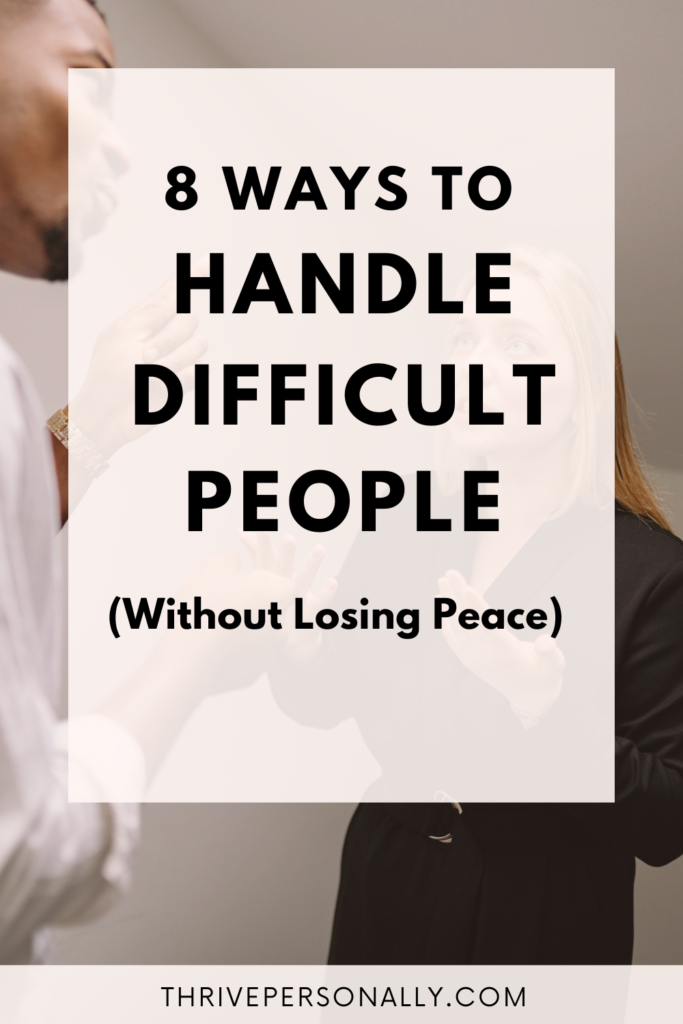Dealing with challenging individuals is an inevitable part of life, whether in personal relationships or professional environments. Recognizing the traits and behaviors that characterize difficult people can empower you to interact with them more effectively.
Common types of difficult individuals often include critics, know-it-alls, and drama queens, each bringing unique challenges to communication and interaction.
The critic is a person who consistently finds faults in others’ work or ideas. They may express their opinions in a blunt manner, often leading to tension and defensiveness.
Another prevalent type is the know-it-all, someone who possesses an air of superiority and a tendency to dominate conversations with their purported expertise.
This behavior can stifle collaboration and incite feelings of inadequacy in others. Recognizing the know-it-all’s need to be right allows you to navigate discussions by seeking common ground, often diffusing tension through shared knowledge rather than confrontation.
The drama queen, characterized by their flair for the theatrical and tendency to exaggerate situations, can disrupt personal and professional environments. They often seek attention and validation, which may lead to emotionally charged encounters.
How to Handle Difficult People Without Losing Your Peace – 8 Tips
1. Recognizing Your Triggers

Understanding what disturbs your peace while interacting with difficult individuals is crucial for maintaining emotional stability. The process of recognizing your triggers involves self-reflection and attentiveness to your feelings in various scenarios.
Triggers can be specific behaviors, words, or attitudes exhibited by others that provoke a strong emotional response in you. Identifying these triggers allows you to prepare for interactions and manage your responses more effectively.
To start this process, take time to reflect on past encounters with difficult people. Consider moments when you felt particularly frustrated or overwhelmed. What specific actions or statements from the other person caused your emotional reaction? By documenting these instances, you can begin to identify patterns in your interactions.
This exercise will shed light on which behaviors you find most bothersome, whether it relates to communication styles, attitudes, or other factors.
Furthermore, maintaining a journal can serve as a valuable tool for tracking your emotions and triggers over time. Note down situations involving challenging people, your initial reactions, and how you felt afterward. Reviewing these entries enables you to recognize recurring themes and helps you better prepare for future interactions.
By developing an awareness of your triggers, you gain insight into your emotional landscape, assisting you in responding with greater calmness.
Read Also: How Hard Work Plays a Key Role in Achieving Your Goals
2. Staying Calm and Collected
Managing interactions with difficult individuals presents a unique challenge that often tests one’s capacity for patience and self-control. To ensure that you maintain your inner peace during these times, employing specific techniques can prove beneficial.
One particularly effective method is deep breathing. Engaging in deep, controlled breaths can significantly reduce stress and refocus your mind. By inhaling deeply through your nose and exhaling slowly through your mouth, you can effectively lower your heart rate and diminish feelings of anxiety, thereby creating a sense of calm amidst chaos.
Another practical technique is the age-old advice to count to ten before responding to challenging remarks or behaviors. This simple yet powerful action allows your emotional response to settle, giving you the opportunity to reflect rather than react impulsively.
Counting to ten provides crucial moments to assess the situation and formulate a thoughtful response, which often leads to more constructive outcomes. It enforces a momentary pause that can be invaluable in high-stress encounters.
Additionally, the use of positive affirmations can foster resilience when confronting challenging individuals. Phrases such as “I am in control of my emotions” or “I choose to respond with kindness” serve to reinforce a calm mindset. Repeating these affirmations, either silently or aloud, can instill a sense of empowerment and help you navigate difficult exchanges with grace.
Moreover, adopting a positive outlook not only uplifts your spirit but also influences those around you, potentially transforming a tense interaction into a more amicable exchange.
Read Also: How to Let Go of Bad Memories and Heal from the Past
3. Setting Healthy Boundaries

Establishing healthy boundaries is an essential skill when dealing with difficult individuals. Boundaries serve as guidelines that define what is acceptable and unacceptable behavior, which can significantly help protect your mental space.
First and foremost, recognize that setting boundaries is not an act of hostility but rather a means of self-care. It is crucial to have a clear understanding of your limits, including emotional, physical, and time-related boundaries, as these can guide your interactions.
When you are ready to set a boundary, articulate it clearly and assertively. Use “I” statements to express your feelings and needs, which can minimize feelings of accusation that may provoke defensiveness.
For example, instead of saying, “You always interrupt me,” you might say, “I feel overlooked when I’m not allowed to finish my thoughts.” This approach can help facilitate a more constructive dialogue without escalating the conflict. Additionally, ensure your body language is confident but calm, and maintain eye contact, which can reinforce your message.
Moreover, practice saying “no” when necessary, as it is a fundamental aspect of maintaining your boundaries. Learning to refuse unreasonable requests can prevent feelings of resentment or guilt that often arise from overcommitting. When you decline, do so graciously but firmly, emphasizing your right to prioritize your own well-being. For instance, you could say, “I appreciate your understanding, but I am unable to take on any additional responsibilities at this time.”
Finally, it is essential to remain consistent. Boundaries must be upheld over time to effectively change the dynamics of difficult relationships.
4. Practicing Empathy
Empathy plays a crucial role when dealing with difficult individuals. It enables us to step outside our own perspectives and understand the feelings, motivations, and experiences of others. Often, challenging behaviors are symptomatic of deeper issues such as stress, insecurity, or personal troubles.
By practicing empathy, we create an opportunity to engage with these individuals on a more compassionate level, shifting our responses from frustration to understanding.
One effective way to practice empathy is by actively listening to what the other person is saying. This involves focusing on both their words and nonverbal cues. By paying attention to their tone, body language, and facial expressions, we can glean significant insight into their emotional state.
This deeper understanding allows us to respond thoughtfully rather than react impulsively. For instance, if a colleague is behaving irritably during a team project, considering their workload or personal challenges could provide clarity on why they may be struggling.
Furthermore, it is important to acknowledge and validate the feelings of those we find difficult. Simple expressions like “I can see you’re feeling overwhelmed” or “It sounds like this really frustrates you” can go a long way in building rapport.
This validation does not mean we condone negative behavior; rather, it demonstrates that we are humanizing the situation and recognizing their emotional reality. When individuals feel understood, they may be more likely to reciprocate with respect and civility, creating a more harmonious interaction.
5. Choosing Your Response Wisely
In our interactions with others, particularly those who exhibit difficult behavior, the ability to choose our responses is crucial. Reacting impulsively can lead to increased tension and conflict, while a measured and thoughtful response can foster understanding and maintain our peace.
The first step in this process is to cultivate awareness of our emotional state when confronted with challenging individuals. Taking a moment to pause allows us to gather our thoughts and reflect on the best course of action.
During this pause, it is essential to consider the potential outcomes of our responses. Think about the implications of your words and actions. Will responding with anger escalate the situation, or will a calm demeanor help de-escalate tension? By weighing our options, we can choose responses that align with our values and desired outcomes, rather than simply reacting out of frustration or hurt.
This intentional approach encourages a deeper understanding of what we truly wish to convey and contributes to meaningful communication.
Read Also: Looking for a Stress-Free Year? Try These 20 Must-Have Apps
6. Knowing When to Walk Away
Recognizing when to detach from a difficult person is crucial for maintaining your mental well-being and emotional health. Acknowledging the signs that indicate a toxic relationship can empower you to choose self-preservation over prolonged distress.
One of the primary indicators that it may be time to walk away is a consistent feeling of negativity or unrest when interacting with certain individuals. If these exchanges leave you feeling drained, anxious, or frustrated, these are clear red flags signaling that the relationship may be harmful.
Another sign to consider is a lack of mutual respect. A healthy relationship is built on reciprocal understanding and regard. If a person consistently undermines your feelings, ignores your boundaries, or engages in manipulative behaviors, it may indicate a need to step back. Additionally, if attempts at communication have been met with defensiveness or aggression, it is often a sign that dialogue is no longer productive, further reinforcing the need for separation.
Your emotional and mental state is paramount. If you find that interactions with a difficult person escalate your feelings of negativity or contribute to stress, it is essential to prioritize your peace of mind. Walking away does not necessarily mean cutting ties completely; sometimes, creating a healthy distance is enough to reclaim your tranquility without abandoning the relationship altogether.
It is also important to assess the impact of the relationship on your life objectives and goals. If you find that the difficult person is hindering your personal growth or professional aspirations, reevaluating the importance of such an association can be beneficial.
7. Seeking Support
Dealing with difficult people can often feel overwhelming, leading to emotional distress and frustration. However, it is essential to recognize that no one has to navigate these challenges alone. Seeking support from friends, family, or professionals can provide invaluable assistance in managing interactions with difficult individuals. Engaging with a trusted confidant allows you to express your feelings and gain a fresh perspective on the situation.
When you share your experiences with those you trust, the act of verbalizing your thoughts can serve as a powerful release. Friends and family members can provide reassurance and validation, which helps in ameliorating feelings of isolation.
They may also share their experiences or strategies for handling similarly challenging interactions, allowing you to learn from their insights. Additionally, simply having someone listen can foster a sense of connection, which is crucial when you feel overwhelmed by difficult people.
In some instances, seeking professional help may be beneficial. Trained therapists or counselors can offer guidance tailored to your specific circumstances, providing tools and techniques to improve your coping strategies. They can assist in identifying underlying patterns in your interactions, helping you develop more effective communication skills and emotional regulation. Professional support may also provide a safe space to explore any anxiety or stress caused by these encounters, promoting overall mental well-being.
8. Reflecting on Your Growth
Throughout the journey of managing interactions with difficult individuals, it is vital to take the time to reflect on your personal growth. Each encounter with a challenging person serves as an opportunity to understand not only their behavior but also your reactions and coping mechanisms.
As you reflect on past experiences, consider how various strategies, such as active listening, empathy, and setting boundaries, have influenced your interactions. Recognizing the evolution of your responses can shed light on the constructive changes you have implemented over time.
Think about specific instances when you encountered difficult people and assess how you handled those situations. Did you resort to conflict or engage in productive dialogue? Were there moments when you successfully maintained your composure amidst adversity? By drawing parallels between past experiences and current strategies, you can identify patterns in your behavior that may require adjustment. This reflective process can enhance your capacity to remain peaceful, even when faced with challenging personalities.
Moreover, personal growth is an ongoing journey, one that demands consistent self-evaluation and adaptation. Each interaction with difficult individuals provides further insight into your strengths and areas for improvement. Embrace these experiences, as they contribute to your development and resilience. As you apply the learned strategies, you foster an environment conducive to constructive interactions, thereby enhancing your overall peace of mind.
Save the pin for later



